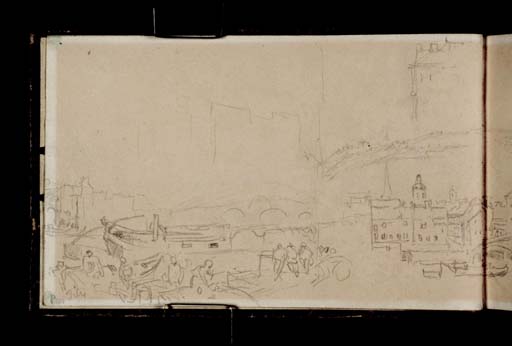Joseph Mallord William Turner The Waterfront at Huy, Looking Upstream to the Bridge, Church of Notre-Dame and the Citadel, with Bargemen Working and Resting on the Quay; The Citadel, Church and Bridge at Huy, Looking Upstream 1824
Image 1 of 2
-
 Joseph Mallord William Turner, The Waterfront at Huy, Looking Upstream to the Bridge, Church of Notre-Dame and the Citadel, with Bargemen Working and Resting on the Quay; The Citadel, Church and Bridge at Huy, Looking Upstream 1824
Joseph Mallord William Turner, The Waterfront at Huy, Looking Upstream to the Bridge, Church of Notre-Dame and the Citadel, with Bargemen Working and Resting on the Quay; The Citadel, Church and Bridge at Huy, Looking Upstream 1824 -
 Joseph Mallord William Turner, The Waterfront at Huy, Looking Upstream to the Bridge, Church of Notre-Dame and the Citadel, with Bargemen Working and Resting on the Quay; The Citadel, Church and Bridge at Huy, Looking Upstream 1824 (Enhanced image)Enhanced image
Joseph Mallord William Turner, The Waterfront at Huy, Looking Upstream to the Bridge, Church of Notre-Dame and the Citadel, with Bargemen Working and Resting on the Quay; The Citadel, Church and Bridge at Huy, Looking Upstream 1824 (Enhanced image)Enhanced image
Joseph Mallord William Turner,
The Waterfront at Huy, Looking Upstream to the Bridge, Church of Notre-Dame and the Citadel, with Bargemen Working and Resting on the Quay; The Citadel, Church and Bridge at Huy, Looking Upstream
1824
Joseph Mallord William Turner 1775–1851
Folio 2 Verso:
The Waterfront at Huy, Looking Upstream to the Bridge, Church of Notre-Dame and the Citadel, with Bargemen Working and Resting on the Quay; The Citadel, Church and Bridge at Huy, Looking Upstream 1824
D20087
Turner Bequest CCXVII 2 a
Turner Bequest CCXVII 2 a
Pencil on off-white wove paper, 99 x 162 mm
Watermark ‘[...]lls | 1[...]’
Inscribed in pencil by Turner ‘Pan Tiles’ bottom left
Watermark ‘[...]lls | 1[...]’
Inscribed in pencil by Turner ‘Pan Tiles’ bottom left
Accepted by the nation as part of the Turner Bequest 1856
Exhibition history
1904
National Gallery, London, various dates to at least 1904 (601f, as ‘Ten Leaves from a Book of Sketches on the Rhine and Meuse’).
1991
Turner’s Rivers of Europe: The Rhine, Meuse and Mosel, Tate Gallery, London, September 1991–January 1992, Musée Communal d’Ixelles, Brussels, February–April 1992 (38, reproduced).
References
1904
E.T. Cook and Alexander Wedderburn eds., Library Edition: The Works of John Ruskin: Volume XIII: Turner: The Harbours of England; Catalogues and Notes, London 1904, pp.302, 636 no.601f, as ‘Ten Leaves from a Book of Sketches on the Rhine and Meuse’.
1909
A.J. Finberg, A Complete Inventory of the Drawings of the Turner Bequest, London 1909, vol.II, p.682, as ‘Continuation of drawing on p.3. Reverse of Exhibited Drawing, 601b, N.G.’.
1975
Malcolm Cormack, J.M.W. Turner, R.A. 1775–1851: A Catalogue of Drawings and Watercolours in the Fitzwilliam Museum, Cambridge, Cambridge 1975, pp.56 no.29; 64 no.41 note 1 [p.68].
1991
Cecilia Powell, Turner’s Rivers of Europe: The Rhine, Meuse and Mosel, exhibition catalogue, Tate Gallery, London 1991, p.41 note 15 [p.60], 123 no.38 reproduced.
The foreground of this sketch of the Belgian city of Huy is bustling with activity, and is peopled with tradesmen, fishermen, bargemen, and quayside workers who converse, exchange, and toil at the Quay Dautrebande on the Meuse. Huy had for centuries been a commercial and artisanal hub, noted for its cloth-making and woodworking industries, smelting works, and tanneries.1 These economies were contingent on the transport links provided by the Meuse, one of Europe’s major rivers and the means by which wares could be imported and exported. In this sketch, Turner makes note of one particular trade in ‘Pan Tiles’, inscribed at bottom left to mark out the cargo of one of the barges.
Here Turner shows attentiveness to daily life and labour and an interest in recording what exists in lively animation beyond the city’s celebrated historic landmarks. One of these monuments, the citadel, is visible on the other side of the bridge and is rendered in profile with cursory line. The proportions of the citadel and its impregnable, perpendicular angularity bring to mind the journalist and author Dudley Costello’s observation that the fortress seemed ‘suspended above the cathedral, as if to threaten it with instant ruin’.2
The remaining third of the page, closest to the gutter of the book, is roughly squared off with a single line. The view within is a continuation of that shown on Tate D20088; Turner Bequest CCXVII 3, a detailed recording of the cathedral and citadel at Huy.
For other views of Huy in this sketchbook see Tate D20089–D20093, D20109–D20110; Turner Bequest CCXVII 3a–6a, 16–17. See also the Rivers Meuse and Moselle sketchbook of the same date (Tate D19622–D19635; Turner Bequest CCXVI 36–43) and the Brussels up to Mannheim sketchbook of 1833 (Tate D29653, D29656–D29659, D29661–D29662, D29768, D29771; Turner Bequest 29, 30a–32, 33–33a, 90, 91a). Later drawings include: Tate D28048, D28053, D28057, D28067, D28096, D28131–D28137, D28139–D28143, D28147, D28149; Turner Bequest CCLXXXVII 4, 6a, 8a, 13a, 28a, 47a–50a, 51a–53a, 56a, 57a. There are also a number of colour sketches in gouache with watercolour and pen and ink produced on blue paper dated around 1839 (Tate D20221, D20222, D20226, D20268, D20288; Turner Bequest CCXX N, O, S; CCXXII I, CCXXIII C).
Technical notes:
The paper has mottled and browned significantly, a result of the drawing’s prolonged exhibition and exposure to sunlight during the nineteenth century.
Alice Rylance-Watson
January 2014
How to cite
Alice Rylance-Watson, ‘The Waterfront at Huy, Looking Upstream to the Bridge, Church of Notre-Dame and the Citadel, with Bargemen Working and Resting on the Quay; The Citadel, Church and Bridge at Huy, Looking Upstream 1824 by Joseph Mallord William Turner’, catalogue entry, January 2014, in David Blayney Brown (ed.), J.M.W. Turner: Sketchbooks, Drawings and Watercolours, Tate Research Publication, April 2015, https://www

